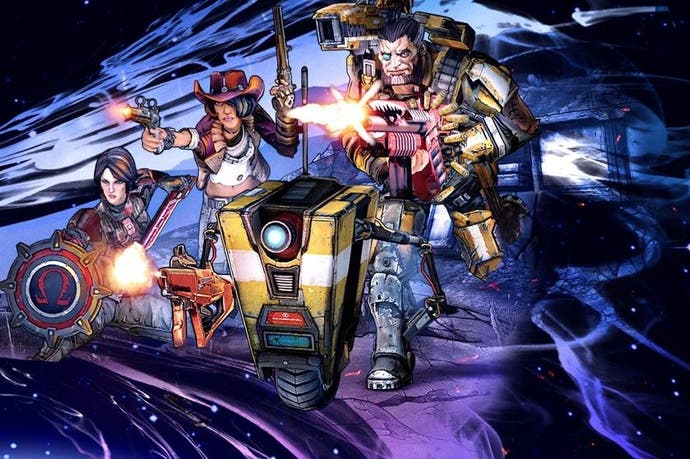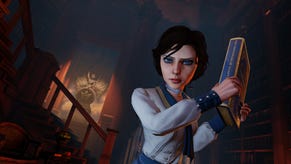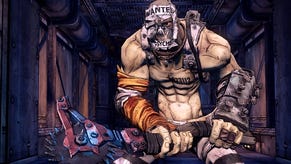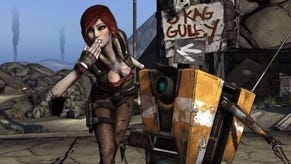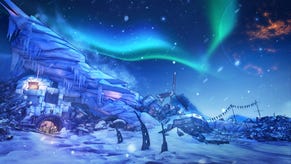Borderlands: The Pre-Sequel review
Crater expectations.
The exclamation mark clinging to the title of this Borderlands spin-off - on its box, if not on this website - makes a promise that the game itself sadly can't quite keep. This is a series that has always tipped towards zany characters and anarchic cartoon energy, yet for all its excitable punctuation, there's a noticeable shortage of those elements in Borderlands: The Pre-Sequel.
This is a game set before Borderlands 2, yet narrated in flashback after the events of that game. This time, the quartet of playable characters is drawn from the ranks of previous enemy bosses. There's Athena, from The Secret Armory of General Knoxx expansion, who uses a shield in much the same way as Captain America. There's Nisha, sheriff of Lynchtown, whose abilities are based on gunplay. There's Wilhelm, whose abilities centre on cyborg implants and a pair of remote drones which attack enemies and heal the player. Finally, there's comedy robot Claptrap, whose VaultHunter.EXE ability causes random effects based on the situation. Sometimes they involve dancing or meat unicycles.
All are working on behalf of Handsome Jack, the villain of Borderlands 2. Much of the plot is spent establishing the origins of characters and plot threads from the last game, making it difficult to recommend to newcomers. If you're not familiar with the role that the Helios space station is destined to play, or the robot army that Jack relied on, many of the missions here will feel disconnected.
As always with Borderlands, what pulls it all together is the strong systemic core which balances a generous spread of randomly generated weaponry against multiple upgrade paths, all of which knit together to create an experience with enviable forward momentum. The finer details of the story may pass you by, but that's OK because you're always looking for your next favourite weapon, working towards that next ability on the skill tree, or earning that next Badass Rank from dozens of ambient challenges that increase your stats across all characters, a fraction of a per cent each time. Upgrades unlock early and regularly thereafter, and the spread of skill trees is such that you can play the same character multiple ways.

That's the beating heart of Borderlands and 2K Australia, taking the development reins from series creator Gearbox, has wisely opted not to mess about with anything too radically. The headline gameplay additions are a new type of elemental damage and the low-gravity, zero-atmosphere possibilities opened up by the game's setting: Elpis, the moon orbiting Pandora, the planet on which the previous games took place.
The new element is cryo, a rather disappointing addition that feels so obvious and predictable that I had to double-check it wasn't in the previous games. Certainly the ability to freeze enemies and shatter them is nothing new in any video game, let alone shooters, and while it's well implemented it doesn't provide the sort of gameplay jolt you'd expect from a game with a wacky exclamation mark in its title.
Gravity and atmosphere prove more decisive in the changes they bring to the game.In outdoor areas, you'll start to lose oxygen. This is stored in a new default character item, which like everything else can be swapped out for improved models. Your "Oz" dispenser not only keeps you breathing in the vacuum but allows for boosted jumps - assisted by low gravity - and ground slams.
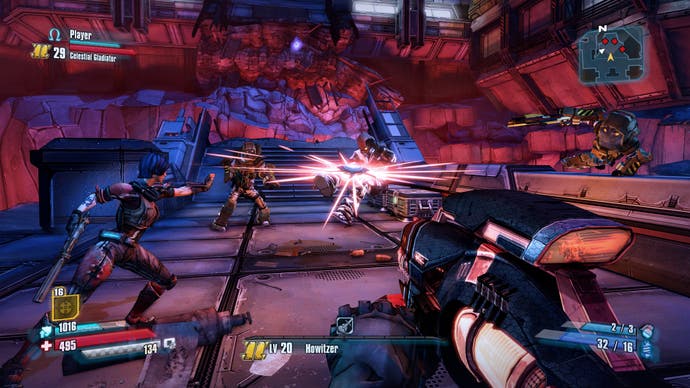
Initially, it's a lot of fun and the ability to soar, glide and smash tweaks the otherwise familiar Borderlands formula in enjoyable ways. It does mean that movement on foot is ultimately even more hassle than usual, though. Your oxygen can be topped up from vents on the moon surface or man-made oxygen bubbles, but this turns traversing large areas without a vehicle into an awkward, stop-start game of leapfrog as you hunt for the next safe spot. It's yet another gauge to keep an eye on and, once the novelty of low gravity has worn off, a not entirely useful one.
More problematic is the impact those low-gravity leaps have had on mission design. Now players are able to spring into the air and slowly descend, the temptation to make this part of the gameplay proves impossible to resist. As a result, too many objectives are tucked away, reachable only by mildly frustrating 3D platforming using boost pads to get around.
The only other major addition to the existing Borderlands template is the new Moonstone currency. Similar to Eridium in Borderlands 2, this space ore can be traded on the black market at the game's hub area to improve weapon slots and expand your inventory. Unlike Eridium, moonstone is generously supplied - often dropped by enemies and found in chests and loot boxes. That's because you can also use moonstone in the Grinder, a new machine that combines three weapons of the same rarity into a single weapon of a higher tier. Adding moonstone to the mix guarantees a more impressive result.
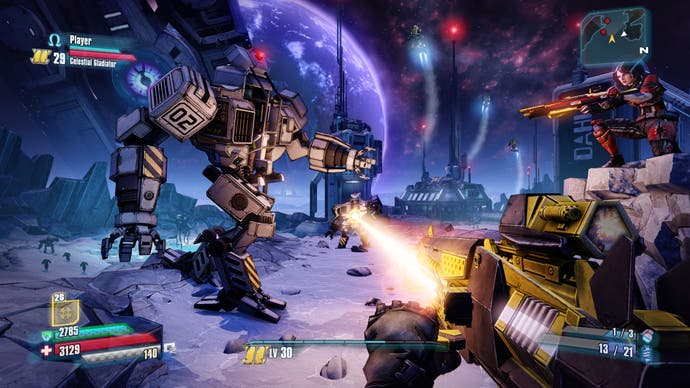
It seems like a minor addition, and clearly not the sort of thing sexy enough to be shouted about in press releases, but it proves to be the game's single best idea in the long term, offering a new economy to play for when hoarding weapons. No longer do you have to store or discard unwanted or low-powered loot. Now you can roll the dice on getting something better and clear some inventory slots at the same time.
That's about it as far as new ideas go, as it's otherwise business as usual - a state of affairs made clear by the fact this is emphatically not Borderlands 3, but a spin-off side dish.
That means once again keeping one eye open for the telltale green glow of a loot crate; lots of circle-strafing around enemies that become increasingly bullet-spongey as you ascend through the levels; and some frustrating boss fights that trap you in enclosed arenas and spam you with attacks. As always, the idea is that you'll be supported by friends in co-op, and while the game is more fun to play solo than certain rivals (yes, Destiny, that means you), this is still a game where you'll want a full lobby to really push the pieces into place.
2K Australia has done a good job of mimicking Gearbox and has even added an antipodean flavour, with Aussie accents and slang throughout the game. The flavour doesn't last, however, and as the hours tick by it's hard to avoid feeling that The Pre-Sequel is sorely lacking when it comes to memorable new characters. Too many are bland quest givers, and the few bright spots of humour tend to be squirreled away in side missions. There's a lot of padding as well, with the sort of mission design where no door opens and no machine works first time, sending you from one waypoint to another in barely disguised busywork. That was arguably true of the previous games as well, but there's a slight lack of spark here that highlights the paucity of stand-out moments.
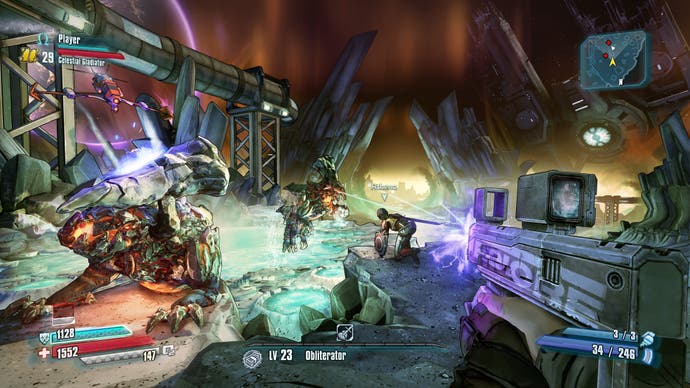
I absolutely loved Borderlands 2 - right up to the point where it swallowed my saved game, erasing months of progress. I didn't encounter anything quite so terrible in The Pre-Sequel, but it's still a game obviously straining at the limits of its engine. Textures pop in slowly, visual and audio glitches are common and the game often freezes for a second when too much is going on. Again, nothing that fans of the series won't already have come to terms with, but it underlines the notion that this is a stop-gap rather than a step forward.
I can't deny that I enjoyed clicking back into the enjoyable mechanisms of Borderlands, but while I sucked the very marrow out of the previous game, I found myself growing tired of The Pre-Sequel long before reaching the end of my first playthrough. I suspect the generous and often outstanding download add-ons for Borderlands 2 can't have helped, since they seem to have satisfied my hunger for that game - and any near-identical game - for the foreseeable future.
The Pre-Sequel, then, does what it had to do but not much more. It offers more Borderlands, leaning heavily on existing characters and gameplay ideas, while sprinkling some new concepts on top but not enough to feel like a new game in its own right. Too big for DLC yet not different enough for a sequel, think of it as a familiar snack served up too soon after an enormous buffet.
